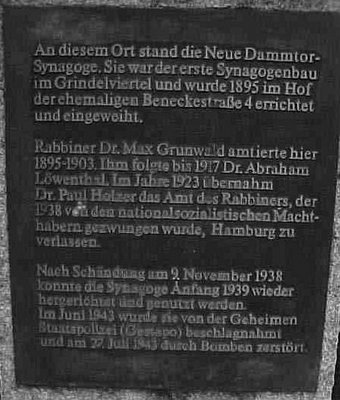
[monument on the former site of the neue dammtor synagogue in hamburg, germany, destroyed during the reichskristallnacht or "schandung am 9 november 1938" as so described]
early in 1938, the polish government gave its citizens living abroad for more than five years until october 31 of that year to receive a special stamp in their passports. failure to do so would result in loss of their polish citizenship. polish jews attempting to obtain those special stamps were denied them: approximately 50,000 polish jews were to become stateless as a result. germany was home to 17,000 of these unfortunate people—many of whom had lived there for decades, including decorated german veterans of world war I. not wanting to be saddled with 17,000 stateless Jews, on october 27-28, 1938, the nazi government cruelly rounded up those people and dumped them in freezing weather in a no-man’s land on the german-polish border—not wanted by either country. (german authorities finally persuaded the polish government to relent.)
hershl grynszpan, 17 year old son of one of these uprooted families, was living in paris. furious at the expulsion and pauperization of his family (who had lived in hanover), grynszpan had resolved to assassinate the german ambassador. on november 7 he went to the german embassy where he shot and fatally wounded ernst vom rath, its third secretary (and ironically an anti-nazi).
in the wake of vom rath’s death (and using that event as a pretext), the nazi leadership and its minions sprang into action with a “spontaneous” and deadly attack on germany’s already besieged jewish community. because of broken windows from destroyed jewish-owned shops that littered the streets of cities throughout germany, the rioting, destruction and terror of november 9-10 came to be known as kristallnacht. damaged, and in many cases destroyed, were 1,574 synagogues (nearly all those found in germany), many jewish cemeteries, more than 7,000 jewish-owned shops, and 29 department stores. upwards of 20,000 jews were arrested and sent to concentration camps (where some died) and the number of jews killed in the violence is usually cited at 91, though it is doubtful that number is accurate.
this opening salvo of what was to become the holocaust found thousands of german jews lined up at consulate after consulate in a vain attempt to escape. no country wanted them. furthermore, the german government found jews “responsible” for these events—being held legally and financially responsible for the damages incurred by the pogrom. the german jewish community was assessed a fine of 1 billion marks for the slaying of vom rath. six million marks paid to jews by insurance companies for broken windows was to be given to state. In the weeks after the terror, anti-jewish laws were enacted exponentially.
yet even in those dark days, there were other voices. In the wake of the kristallnacht’s horror, father bernard lichtenberg, provost of berlin’s st. hedwig's cathedral, offered public prayers for the jews. he later died in transit to dachau. when arsonists set fire to berlin’s oranienburgerstrasse synagogue, wilhelm krützfeld, a non-jewish police officer, called on the local fire brigade to save the building by courageously citing the building’s landmark status.
No comments:
Post a Comment